Although I ride, I have never ridden side saddle. I remember as a little girl being allowed to side on a saddle at an historical property in Victoria called Bontharambo. I have never forgotten that day. It always looks so glamorous though, don’t you think?

Henride Montpezatd Ainecy - Elegant Lady Riding Her Horse Sidesaddle
Until about the mid 1500s women wore their everyday day clothes for riding. The first habits were often military looking, copying the uniforms of the male riders of the day. Gradually riding habits evolved – what was one more change of dress in the day if you had servants to help you? Given the cost of the saddle the horse and the habit, and the fact that a lady needed assistance to mount side saddle, only women of substance could afford to ride at all.
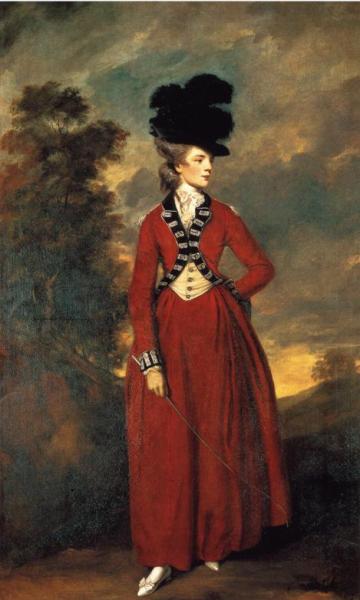

Lady Worsley by Sir Joshua Reynolds, 1776 and Portrait of a Lady in a Riding Habit by Enoch Seeman the younger source
During the Victorian era riding habits tended to follow fashion of the day, but unlike the day clothes of the time, riding habits were sombre in colour (earth colors like blue, green brown and also black) with little trim - any colour or trim was seen in the utmost of bad taste. Riding habits were also made by men’s tailors, rather than seamstresses, so the colours and fabrics would have been the same as used n men’s clothing and uniforms. In tropical climates and the colonies, such as India and Africa and Australia, the habits would have been lighter in colour – cream or beige – just as men’s suits and uniforms would have been.
 Different riding habits were also worn for different occasions. One for use when riding in the park, a simpler version for summer wear, and those that hunted had a distinct habit for hunting. They were all highly tailored however, often with a jacket with a basque bodice - form fitting with boning, fully darted and high collared, with decorative front buttons and a separated small tail.
Different riding habits were also worn for different occasions. One for use when riding in the park, a simpler version for summer wear, and those that hunted had a distinct habit for hunting. They were all highly tailored however, often with a jacket with a basque bodice - form fitting with boning, fully darted and high collared, with decorative front buttons and a separated small tail.


From the 1830's through the early 1870's the skirt was full and flowing and although picturesque, could cause a danger to both rider and horse. In 1875, the first safety skirt was introduced , with it longer on the left side and the front to hide the feet while sitting side saddle but shorter on the right side to make dismounting easier and faster. When walking the extra length was draped around the right hip and fastened at the centre back waist with a button and ribbon loop, as in the small photo below. Either drawers, or soft leather breeches were worn underneath the skirt, and a silk undervest and corset would have been worn under the bodice. By about the 1910 the skirt evolved into the open-sided apron with no back, which was worn with matching pants or jodhpurs. When mounted it would not be known that it was only an apron because of the way it has been designed to sit on the rider.
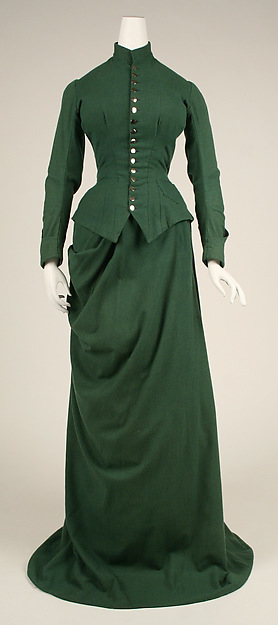
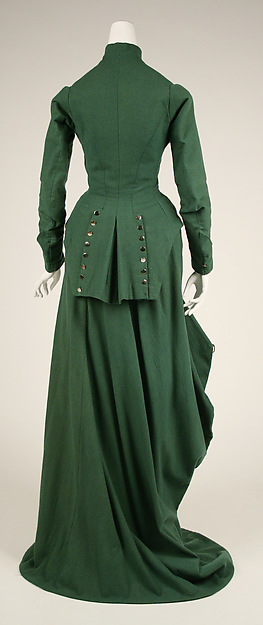
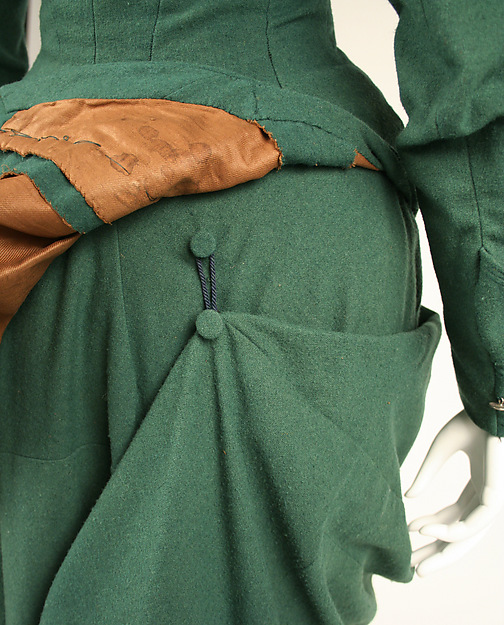
American wool riding habit c. 1875
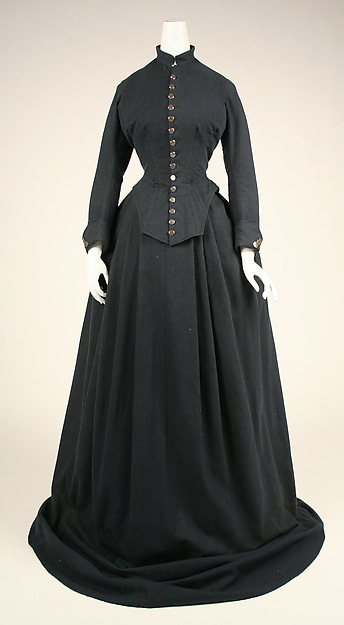
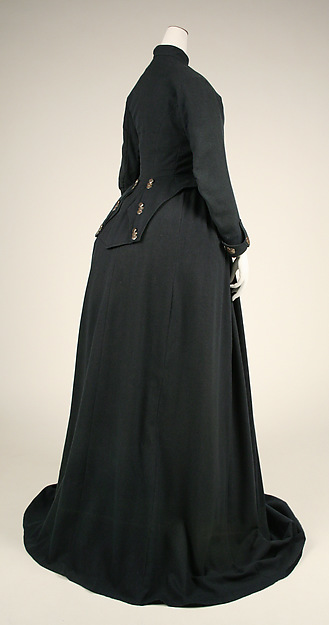
American wool riding habit c. 1880
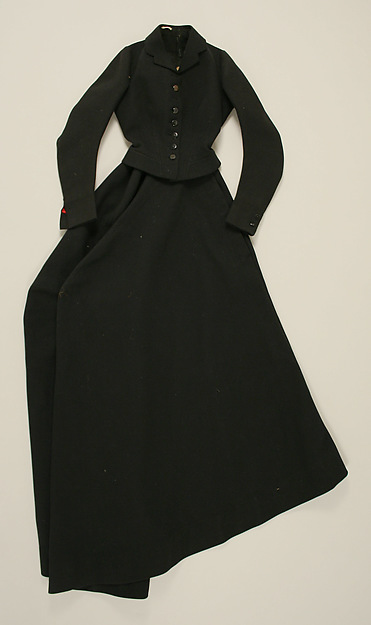
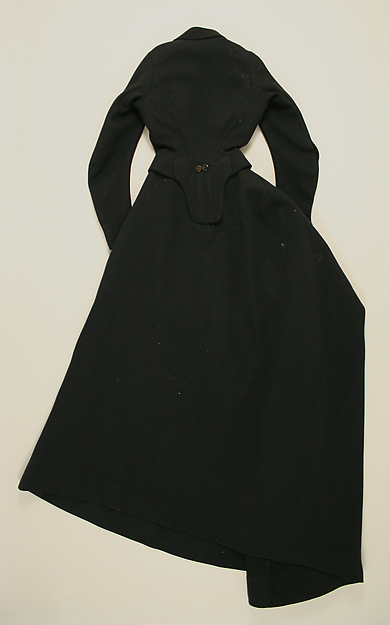
British wool riding habit c 1880-83
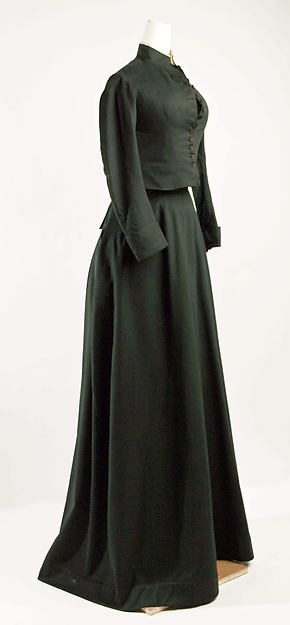
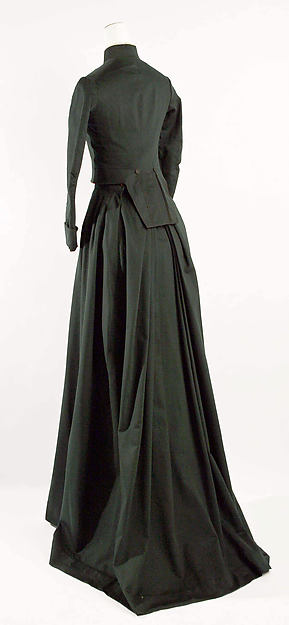
French wool riding habit c. 1887
Here is a short little video I found that shows two ladies in traditional Victorian riding habits, as well as how to sit and ride side saddle.
The photos of outfits were found at this source.
If your are interested, here are some side saddle links.
The Side Saddle Association – UK
The American Side Saddle Association
Side Saddle Ireland
Side Saddle Association of South Australia
Side saddles and suffragettes article
SideSaddle Wiki
Riding Aside – how to guide
And Where to Buy:
Side Saddle .com – UK site with mail order – you can buy everything here including habits
Wendy’s Saddlery - Australian saddle maker who makes custom side saddles
Hundred Oaks – American side saddles including English and Western
Tattersalls Side Saddles – Canadian site with saddles and western clothing
Side Saddle Dressmaking Patterns – UK online site with copies of original period patterns
Ageless Patterns – riding habits of the late 1880s and other period patterns
SSA - More patterns
Deb xxx

Henride Montpezatd Ainecy - Elegant Lady Riding Her Horse Sidesaddle
Until about the mid 1500s women wore their everyday day clothes for riding. The first habits were often military looking, copying the uniforms of the male riders of the day. Gradually riding habits evolved – what was one more change of dress in the day if you had servants to help you? Given the cost of the saddle the horse and the habit, and the fact that a lady needed assistance to mount side saddle, only women of substance could afford to ride at all.


Lady Worsley by Sir Joshua Reynolds, 1776 and Portrait of a Lady in a Riding Habit by Enoch Seeman the younger source
During the Victorian era riding habits tended to follow fashion of the day, but unlike the day clothes of the time, riding habits were sombre in colour (earth colors like blue, green brown and also black) with little trim - any colour or trim was seen in the utmost of bad taste. Riding habits were also made by men’s tailors, rather than seamstresses, so the colours and fabrics would have been the same as used n men’s clothing and uniforms. In tropical climates and the colonies, such as India and Africa and Australia, the habits would have been lighter in colour – cream or beige – just as men’s suits and uniforms would have been.
 Different riding habits were also worn for different occasions. One for use when riding in the park, a simpler version for summer wear, and those that hunted had a distinct habit for hunting. They were all highly tailored however, often with a jacket with a basque bodice - form fitting with boning, fully darted and high collared, with decorative front buttons and a separated small tail.
Different riding habits were also worn for different occasions. One for use when riding in the park, a simpler version for summer wear, and those that hunted had a distinct habit for hunting. They were all highly tailored however, often with a jacket with a basque bodice - form fitting with boning, fully darted and high collared, with decorative front buttons and a separated small tail. 

From the 1830's through the early 1870's the skirt was full and flowing and although picturesque, could cause a danger to both rider and horse. In 1875, the first safety skirt was introduced , with it longer on the left side and the front to hide the feet while sitting side saddle but shorter on the right side to make dismounting easier and faster. When walking the extra length was draped around the right hip and fastened at the centre back waist with a button and ribbon loop, as in the small photo below. Either drawers, or soft leather breeches were worn underneath the skirt, and a silk undervest and corset would have been worn under the bodice. By about the 1910 the skirt evolved into the open-sided apron with no back, which was worn with matching pants or jodhpurs. When mounted it would not be known that it was only an apron because of the way it has been designed to sit on the rider.



American wool riding habit c. 1875


American wool riding habit c. 1880


British wool riding habit c 1880-83


French wool riding habit c. 1887
Here is a short little video I found that shows two ladies in traditional Victorian riding habits, as well as how to sit and ride side saddle.
The photos of outfits were found at this source.
If your are interested, here are some side saddle links.
The Side Saddle Association – UK
The American Side Saddle Association
Side Saddle Ireland
Side Saddle Association of South Australia
Side saddles and suffragettes article
SideSaddle Wiki
Riding Aside – how to guide
And Where to Buy:
Side Saddle .com – UK site with mail order – you can buy everything here including habits
Wendy’s Saddlery - Australian saddle maker who makes custom side saddles
Hundred Oaks – American side saddles including English and Western
Tattersalls Side Saddles – Canadian site with saddles and western clothing
Side Saddle Dressmaking Patterns – UK online site with copies of original period patterns
Ageless Patterns – riding habits of the late 1880s and other period patterns
SSA - More patterns
Deb xxx


I really like your blog and historical dress so amazing...uniforms
ReplyDeleteThank you very kindly
DeleteReally nice article.
ReplyDelete